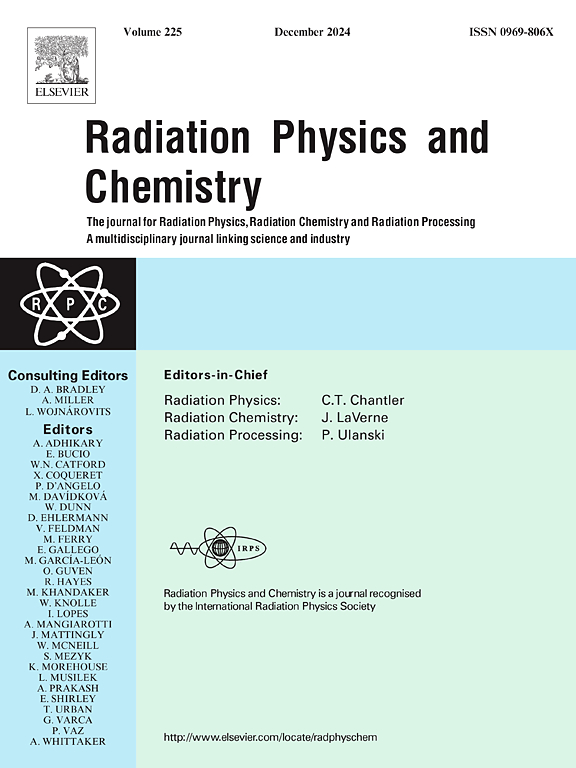Influence of TiO2 content on the radiation shielding properties of the La2O3-B2O3-Gd2O3-Nb2O5-ZrO2-SiO2 glasses
IF 2.8
3区 物理与天体物理
Q3 CHEMISTRY, PHYSICAL
引用次数: 0
Abstract
This paper aims to study the radiation shielding properties of lanthanide glasses, according to the formula xTiO2-51La2O3-(24-x) B2O3–8Gd2O3-8Nb2O5-6ZrO2-3SiO2 (x= 0, 4, 8, 12, 16, wt.%). Using FLUKA Monte Carlo code, the mass attenuation coefficients (MAC), half-value layers (HVL), and effective atomic numbers (Zeff) of the lanthanide glasses were estimated at medical diagnostic energies (between 20 and 150 keV). The MACs of the glasses are between 0.5183 and 24.407 cm2/g for 0Ti, 0.5215-24.788 cm2/g for 4Ti, 0.5193-25.161 cm2/g for 8Ti, 0.5163-25.529 cm2/g for 12Ti, and 0.5183-25.916 cm2/g for 16Ti. These results are consistent with the Phy-X theoretical database (with a percentage difference below 3 %). The lanthanide glasses showed good photon shielding ability compared to lead concrete, and RS-360 & RS-253-G18 commercial glasses, commonly used shielding materials. In this work, 16Ti possesses the highest, lowest, and highest values of MAC, HVL, and Zeff, respectively, at the various energies investigated, which implies that the 16Ti sample has better shielding performance. All in all, this work demonstrated that adding TiO2 to the glass samples could provide preferable shielding features.
二氧化钛含量对 La2O3-B2O3-Gd2O3-Nb2O5-ZrO2-SiO2 玻璃辐射屏蔽性能的影响
本文旨在研究xTiO2-51La2O3-(24-x) B2O3-8Gd2O3-8Nb2O5-6ZrO2-3SiO2 (x= 0, 4, 8, 12, 16, wt.%)式镧系玻璃的辐射屏蔽性能。利用 FLUKA 蒙特卡罗代码,估算了镧系元素玻璃在医疗诊断能量(20 至 150 千伏)下的质量衰减系数(MAC)、半值层(HVL)和有效原子序数(Zeff)。0Ti 玻璃的 MAC 在 0.5183 和 24.407 cm2/g 之间,4Ti 玻璃的 MAC 在 0.5215-24.788 cm2/g 之间,8Ti 玻璃的 MAC 在 0.5193-25.161 cm2/g 之间,12Ti 玻璃的 MAC 在 0.5163-25.529 cm2/g 之间,16Ti 玻璃的 MAC 在 0.5183-25.916 cm2/g 之间。这些结果与 Phy-X 理论数据库一致(百分比差异低于 3%)。与铅混凝土和常用的屏蔽材料 RS-360 & RS-253-G18 商用玻璃相比,镧系玻璃显示出良好的光子屏蔽能力。在这项研究中,16Ti 在各种研究能量下的 MAC、HVL 和 Zeff 值分别最高、最低和最高,这意味着 16Ti 样品具有更好的屏蔽性能。总之,这项研究表明,在玻璃样品中添加二氧化钛可以提供更好的屏蔽功能。
本文章由计算机程序翻译,如有差异,请以英文原文为准。
求助全文
约1分钟内获得全文
求助全文
来源期刊

Radiation Physics and Chemistry
化学-核科学技术
CiteScore
5.60
自引率
17.20%
发文量
574
审稿时长
12 weeks
期刊介绍:
Radiation Physics and Chemistry is a multidisciplinary journal that provides a medium for publication of substantial and original papers, reviews, and short communications which focus on research and developments involving ionizing radiation in radiation physics, radiation chemistry and radiation processing.
The journal aims to publish papers with significance to an international audience, containing substantial novelty and scientific impact. The Editors reserve the rights to reject, with or without external review, papers that do not meet these criteria. This could include papers that are very similar to previous publications, only with changed target substrates, employed materials, analyzed sites and experimental methods, report results without presenting new insights and/or hypothesis testing, or do not focus on the radiation effects.
 求助内容:
求助内容: 应助结果提醒方式:
应助结果提醒方式:


